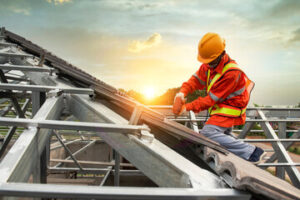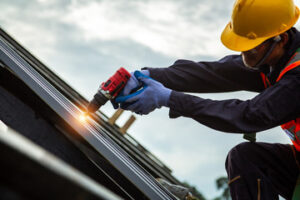Once the roofing installation process is complete, the contractor will clean up the work area, haul away the old shingles and debris and conduct a final inspection. They will also repair and reinforce the roof decking as needed.

Next, the roofer will install flashing, which is a narrow material used to direct water away from critical areas like valleys and where the roof meets a wall or chimney. Then, they will renail the sheathing using a closer nail spacing pattern to reduce the risk of storm-lifting. Visit www.fivestarroofingandcontracting.com/ to learn more.
Slate is a fine-grained, foliated metamorphic rock formed from the alteration of shale and mudstone through low-grade regional metamorphism. It comes in a wide variety of colors and thicknesses that create its characteristic beauty. It’s also very durable, making it a long-lasting roofing material. Slate is a popular choice for homeowners who want to give their homes a classic, old-world style. It can be expensive, but it has a high resale value and requires minimal maintenance.
Slate roofs require more specialized labor and equipment to install than other types of roofing, which increases the cost. A thorough inspection of the existing roof structure is typically done to ensure that it can support the weight of slate tiles and any necessary reinforcement is installed. Then, a high-quality underlayment is applied to the roof deck and metal flashing is installed around any chimneys, vents, or skylights.
Once the flashing is in place, the slate pieces are carefully laid out in overlapping layers across the roof. The topmost layer is then nailed down using copper nails or stainless steel nails. After the slate is in place, any additional trim work, such as installing ridge caps and hip tiles, is completed to provide a finished look.
While slate is an incredibly durable roofing material, it does need some care to keep it looking its best. It’s a good idea to have it professionally cleaned from time to time to remove dirt, moss, and other debris that can damage the tiles. It’s also a good idea to have it inspected regularly by a professional to identify potential issues and have them repaired promptly. Slate is also naturally resistant to mold, mildew, and rot, which can save you from the costly repair bills associated with other roofing materials.
Wood
Wood shingles and shakes are an excellent option for people who want to add an elegant, rustic look to their home. They are available in a variety of styles, and they are extremely durable, lasting 30-40 years. These roofing materials are also natural insulators, keeping your house warmer in winter and cooler in summer. In addition, they are resistant to wind damage, which is a common issue for asphalt shingle roofs.
The most popular choice of wood for roofing is cedar, which offers excellent rot resistance and beauty. However, there are many other options, including redwood, pine and cypress. It is important to choose a type of wood that is certified by the Forest Stewardship Council (FSC) to ensure that it has been harvested ethically and sustainably.
When installing wood shingles or shakes, it is important to have properly spaced sheathing boards. This will ensure that the shingles or shakes are installed evenly, which will prevent water leakage and structural problems. Additionally, the sheathing boards should be fastened using rust-resistant nails.
Another thing to keep in mind when choosing a wood roof is that it will need regular maintenance. You will need to apply chemical treatments that prevent fungus, mold and moss from growing on the roof. You will also need to reapply oil that helps protect the wood from moisture and sun exposure. If you are interested in getting a wood roof, it is best to consult with a professional roofing contractor. They will be able to help you choose the right type of wood for your unique climate and design needs. In addition, they will be able to recommend other roofing materials that may be a better fit for your home.
Clay Tiles
Clay tile roofs are a hallmark of Mediterranean and Spanish inspired architecture. They are a great choice for homeowners who value beauty, durability and added home value. While a bit more expensive than asphalt shingle roofing, a well-installed clay tile roof can last decades and provide unsurpassed aesthetics.
Unlike shingles, which are made from petroleum-based products, clay tiles are manufactured using locally-sourced clay that is heated in a kiln to a high temperature for durability and strength. This makes them a more sustainable roofing material than other options. Additionally, clay tiles are available in a wide variety of colors and styles so you’ll be able to find the perfect match for your home.
While tile roofs are more durable than shingles, they do require regular maintenance to keep them looking and functioning their best. Maintenance includes cleaning to remove moss and algae and sealing to further protect the tiles from rain, snow and UV exposure. It’s also a good idea to check for cracked or broken tiles and replace them as needed.
Like all roofs, clay tiles need proper installation to ensure long-term performance. Unlike shingles, which can be installed with relative ease, clay tiles require special underlayment and fastening methods to prevent moisture damage and leaks. A professional roofing contractor is a good option to consult for these projects as they’ll have the skills, knowledge and tools necessary to install them properly.
Clay and concrete tiles are extremely heavy, so they may require additional roof support to prevent structural damage during installation. They’re also brittle and must be handled carefully to avoid breaking them during the installation process. It’s important to consult with an expert to ensure that your roof is able to support the weight of these tiles before proceeding with your project.
BUR
When you see a roofer spreading a gooey black substance on your commercial building, they are likely using built-up roofing (BUR). BUR is one of the most common flat roof systems in the United States, and it’s also one of the longest lasting. This is because built-up roofing is made up of overlapping layers of waterproof materials like asphalt, tar, and fabrics that work together to create a monolithic membrane.
These layered structures are fused together using hot asphalt or cold adhesives. This process eliminates seams and joints that are prone to leakage, so it can be an excellent choice for commercial buildings in warm climates. Additionally, BUR’s aggregate layer provides UV protection, so it can help reduce energy costs.
While BUR is a durable system, it’s not without its drawbacks. The most significant issue is that the surfacing materials can become damaged by foot traffic or weather. Additionally, the underlying layers can crack or blister under certain conditions. To address these issues, your commercial roofer should perform an annual inspection and make repairs promptly.
A BUR roof has the option to incorporate insulation for improved thermal performance. This can significantly reduce your building’s heating and cooling costs throughout the year. To improve the overall efficiency of your BUR roof, it’s important to select the right products and installation methods.
To ensure your commercial building’s rooftop is built with a quality and sustainable product, select a high-quality base sheet. Elevate’s Ply IV (4) and Ply VI (6) asphalt-impregnated, glass fiber mat reinforced roofing felts are ideal for creating a resilient build up on your commercial roof. These products also provide fire resistance and are easy to install.
Metal
Metal roofing has a classic appeal that is attractive for homeowners looking for an energy-efficient alternative. It can also be fabricated in a range of colors and finishes to complement other roofing materials or create a striking aesthetic.
Unlike corrugated or V-edge sheets that are simply lapped together, site-formed metal roofing is joined with various folded and interlocked seams to form a weatherproof covering. This is particularly useful for roofs where the slope of the surface is too low to rely on simple overlapping.
There are several types of metal roofing, including standing seam, shingle-style and panel-based systems. Each type has advantages and disadvantages. For instance, standing seam panels feature raised seams that snap together to allow the panel to expand and contract naturally as temperatures change. This helps to prevent the accumulated wear of fasteners and improves the overall water-shedding ability of the roof. However, it can be more difficult to maintain the appearance of a standing seam metal roof.
Other common types of metal roofs include galvalume, galvanized steel, copper and aluminum. Each offers different advantages depending on the environment in which it is used. For example, a metal roof in a coastal area must be constructed from materials that are resistant to salty air. Similarly, a galvalume metal roof is built from a carbon steel base that is hot-dipped with aluminum and zinc alloys to reach a coating that is 55% aluminum, 43.4% zinc and 1.6% silicon.
Regardless of the specific type of metal roof, it is important to note that a new metal roof requires regular maintenance and inspections to ensure it continues to perform as intended. In addition, homeowners should be aware that the cost of a new metal roof can vary dramatically based on the design chosen and the material used.
